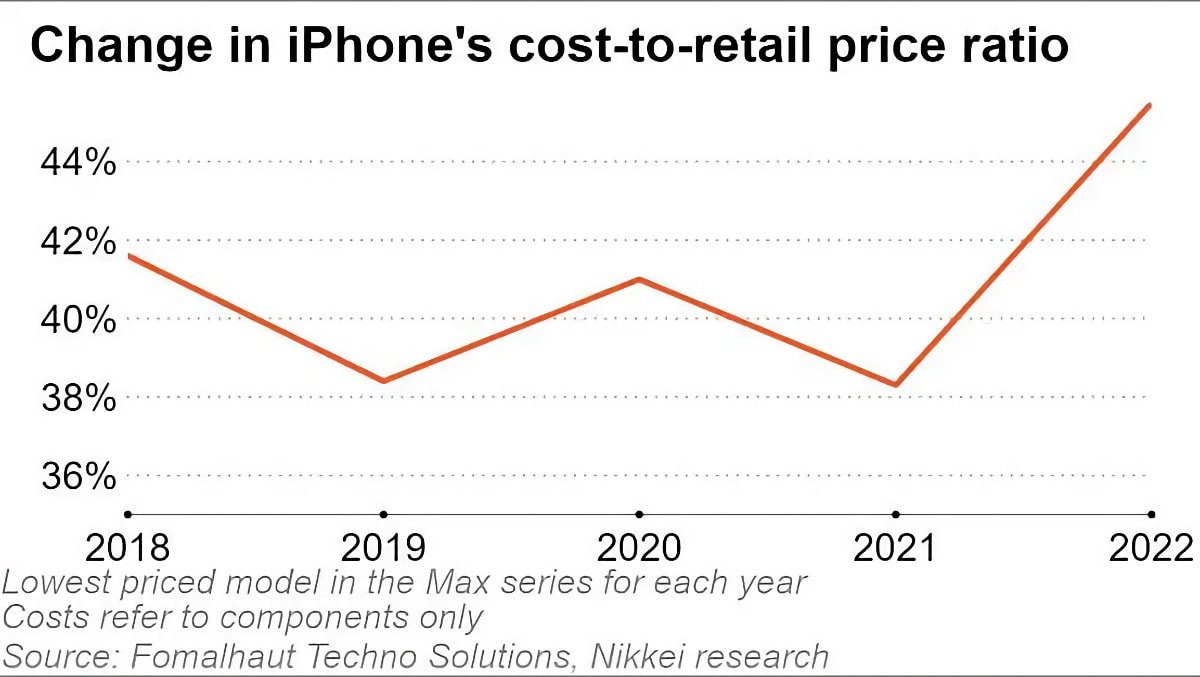A16 Bionic reportedly costs more than twice as much as A15
The A16 Bionic chip found in the iPhone 14 Pro models costs $110 to manufacture, which is 2.4 times more than the A15 found in the iPhone 13 series and in the iPhone 14.

iPhone 14 product line
Nikkei Asia did a teardown of three models in the iPhone 14 series, examining components such as the processor and camera parts. The media company says the new series's production costs are 20% higher than the previous iPhone generation.
In terms of parts, calculations suggest production of the iPhone 14 Pro Max cost Apple $501 in parts, up over $60 from the iPhone 13 Pro Max. The firm calls this a steep production cost, saying parts prices for Max models have ranged between $400 and $450 since the debut of the iPhone XS Max in 2018.
The higher production cost is reportedly due to the A16 Bionic chips in the iPhone 14 Pro models. The chip costs $110, over 2.4 times more than the A15 in the iPhone 13 Pro Max.

The iPhone's cost-to-retail price ratio over the last five years
The A16 Bionic uses a 4-nanometer process from chip supplier TSMC, while the A15 uses a 5-nanometer process. New camera components in the iPhone 14, including Sony's CMOS image sensor, are 30% larger than previous models and cost 50% higher at $15.
Parts for the iPhone 14 primarily come from US suppliers, accounting for 32.4% of costs, up 10% from the iPhone 13. However, South Korea was the top supplier in 2021 and saw its share of manufacturing drop by over five points, down to 24.8%.
The report also claims that since Apple raised iPhone prices in some countries such as Japan and Australia, but not in the US and other markets, higher production costs resulted in lower profits for the company.
But the more likely explanation is foreign exchange rates. The US dollar has been strong in 2022 compared to other currencies, meaning that imports into the country are cheaper for Americans to buy.
Fomalhaut Techno Solutions, a research company based in Tokyo, Japan, helped Nikkei examine the devices.
Read on AppleInsider

iPhone 14 product line
Nikkei Asia did a teardown of three models in the iPhone 14 series, examining components such as the processor and camera parts. The media company says the new series's production costs are 20% higher than the previous iPhone generation.
In terms of parts, calculations suggest production of the iPhone 14 Pro Max cost Apple $501 in parts, up over $60 from the iPhone 13 Pro Max. The firm calls this a steep production cost, saying parts prices for Max models have ranged between $400 and $450 since the debut of the iPhone XS Max in 2018.
The higher production cost is reportedly due to the A16 Bionic chips in the iPhone 14 Pro models. The chip costs $110, over 2.4 times more than the A15 in the iPhone 13 Pro Max.

The iPhone's cost-to-retail price ratio over the last five years
The A16 Bionic uses a 4-nanometer process from chip supplier TSMC, while the A15 uses a 5-nanometer process. New camera components in the iPhone 14, including Sony's CMOS image sensor, are 30% larger than previous models and cost 50% higher at $15.
Parts for the iPhone 14 primarily come from US suppliers, accounting for 32.4% of costs, up 10% from the iPhone 13. However, South Korea was the top supplier in 2021 and saw its share of manufacturing drop by over five points, down to 24.8%.
The report also claims that since Apple raised iPhone prices in some countries such as Japan and Australia, but not in the US and other markets, higher production costs resulted in lower profits for the company.
But the more likely explanation is foreign exchange rates. The US dollar has been strong in 2022 compared to other currencies, meaning that imports into the country are cheaper for Americans to buy.
Fomalhaut Techno Solutions, a research company based in Tokyo, Japan, helped Nikkei examine the devices.
Read on AppleInsider

Comments
The headliner of an A16 SoC costing $110? I call BS on it. Nobody knows. Heck, I bet TSMC and Apple don't even really "know". It's a rather circular contracting arrangement of pre-paying, fixed-priced unit costs, technology funding, so on and so forth. How they determine $/SoC is going to vary with accounting assumptions. At $110, the SoC is 25% of the cost of an iPPM. Sounds crazy. If it was $80, easier to believe.
so A15 costs $46
but A16 costs $110
and Apple is like OK cool?
people need to stop being dumb and believe everything on internet
TSMC may need to be more appreciative
Current US administration seems to have no capacity to insist on peaceful solution other than continue to escalate war and do whatever Ukraine wants
I would not be surprised if Putin drops a couple Nukes on Kyiv next week as retaliation for the car bomb killing civilians.
Over 200%? That's crazy. Apple would have stuck with 5nm and started to look at Samsung and Intel for fab services if so, and they would have started 2 years ago when contract negotiations would have been done. So, people should be skeptical of that number until proven otherwise.
Apple did not raise prices on the iPhone 14 Pro and Pro Max. A 240% increase in the SoC implies about a $70 to $80 cost increase. That's about a $200 increase at the MSRP level. And, it doesn't include increases in other components. No OEM is going eat such component price increases without increasing the price of the product. Given that Apple didn't raise prices, their component costs didn't increase either. Maybe they eat 10%? Maybe?